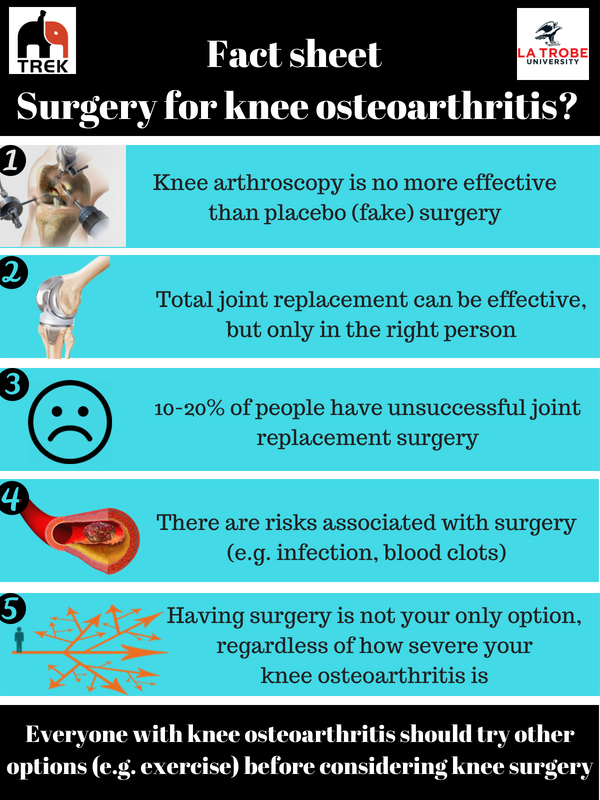Surgery is considered third-line treatment for people with knee osteoarthritis. That means that it is usually only considered after extensive first and second line treatments have been attempted. There are different types of surgical approaches that is currently used to treat knee osteoarthritis. This section was designed to inform you about the different types of surgeries so that you may learn more about this approach.
Let’s learn more about surgery by watching our video with Ali Gibbs, a specialist physiotherapist and knee osteoarthritis researcher.
Frequently Asked Questions (FAQs)
There is no standardised answer to this question. The decision to have surgery is one that needs much thought and discussion between yourself and your surgeon. Consideration of others (e.g. spouse or friends and family) may also be needed to overcome barriers.
There are some decision making tools available. This information pack has been put together by the Australian government to facilitate overall decision making, including surgery. The downside is that this is not a very interactive resource.
This tool is an online decision making tool from the U.K. that provides the benefits and risks of surgery based upon you. There is more information on this tool, including a short video with the creators and people who have used the tool to facilitate decision making here. It’s important to note that there may be subtle differences between the countries, however the overall flow and questions asked may help you facilitate a discussion and decision with your surgeon.
There are a few surgical options to consider for someone with knee osteoarthritis:
- A total joint replacement (also known as arthroplasty) is the most common surgery for people with knee osteoarthritis. In this surgery they replace the surfaces of the thigh pone (femur) and the shin bone (tibia).
- A partial knee replacements is where just half of the knee joint is replaced.
- A tibial osteotomy is a procedure to straighten a deformity of the knee. Usually this involves removing part f the shin bone (tibia), just underneath the joint surface
DID YOU KNOW?
Key hole surgery (arthroscopy) is not an effective treatment option for people with knee osteoarthritis. It is now only recommended if people have a mechanical blocking of the knee.
Yes!
It absolutely is possible to avoid surgery. See the below examples of people who have avoided surgery through making positive changes to their lifestyle and significantly improving their knee symptoms.
Phil:
Lawrence:
Approximately 1 in 5 people (20%) are dissatisfied with their outcomes after a knee replacement. Research is still investigating why this is the case. It is important to have thoroughly researched the risks and benefits before deciding whether you want to undergo surgery.
Have a look at this tool again, which is an online decision making tool from the UK. It provides you with the benefits and risks of surgery based upon you. There’s also a short video to facilitate your decision making (which can be found here). Remember that it this resource is from the UK, so there may be subtle difference between this tool and the one created in Australia. Nevertheless, the overall flow and questions asked might help inform your decision and facilitate a discussion with your surgeon.
Absolutely !!
It is essential that you undergo extensive rehabilitation after your knee surgery. This should be discussed in-depth with your physiotherapist or surgeon when deciding whether surgery is right for you.
Resources and additional information:
Under construction. French for surgery quote
Next – Test your knowledge about treatments

